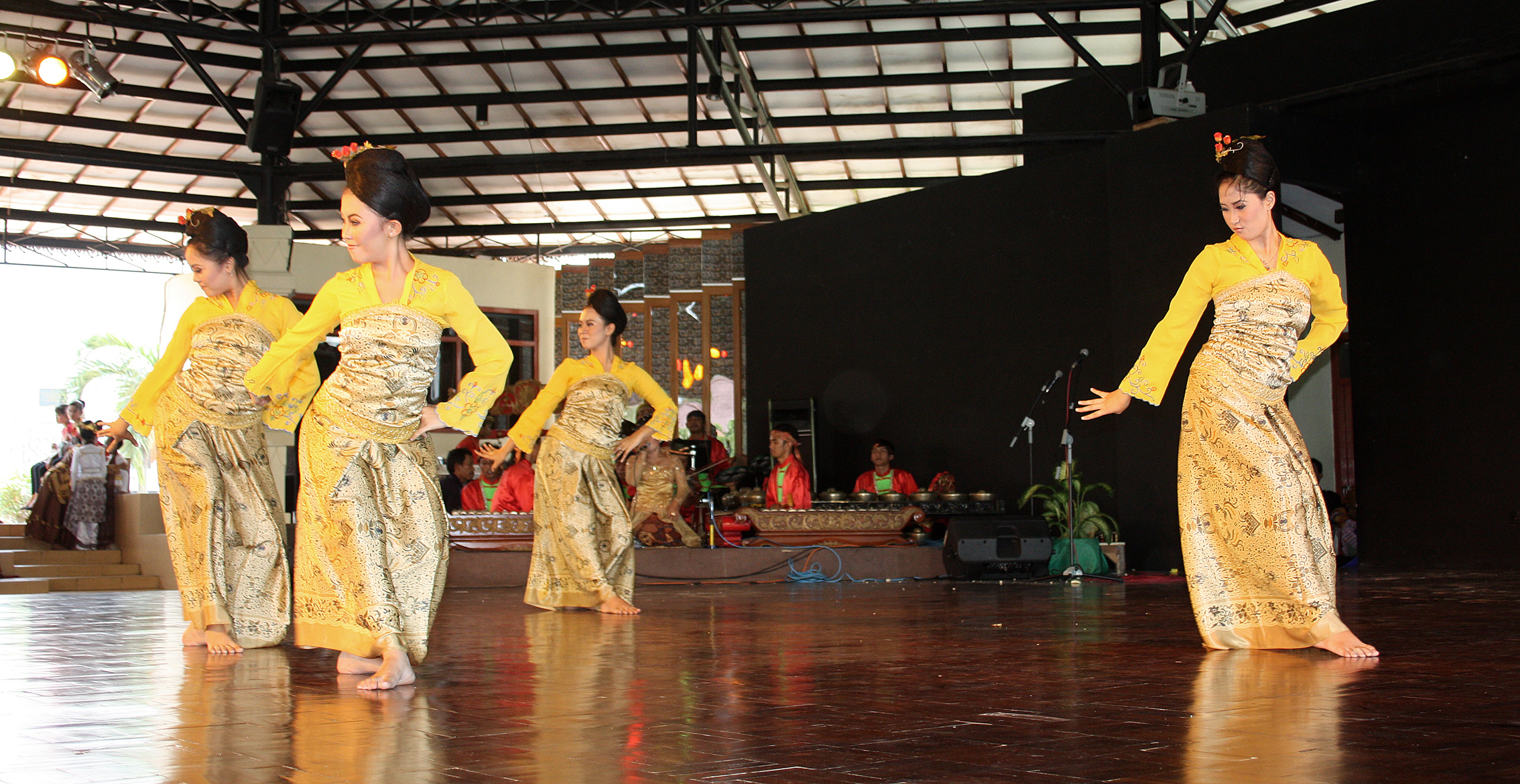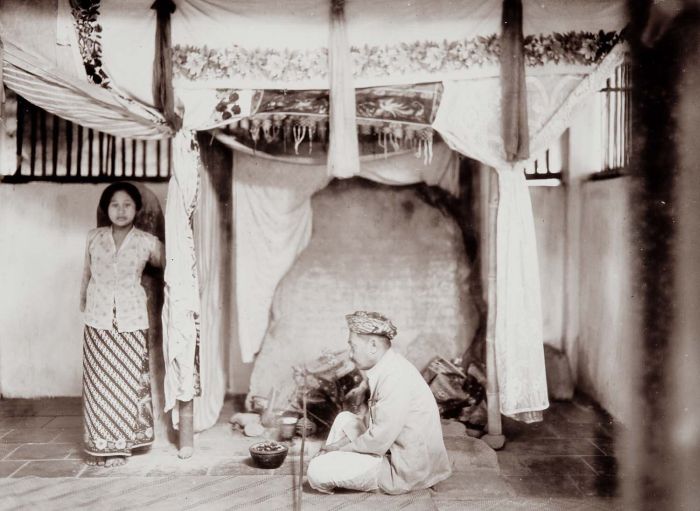|
Bajidor Kahot
( su, ᮘᮏᮤᮓᮧᮁ ᮊᮠᮧᮒ᮪) is a Sundanese dance from Indonesia which combines the dance movements of and as the basic of its motions. What distinguishes them from the two, dance doesn't optimize shoulder movement as the and does. In the dance, hips, arms, shoulders, head, and hands move dynamically. Footsteps also incorporated into the dance. The dancers wear typical Sundanese . The is designed fit the shape of the body and the clothes are brightly colored. Additional accessories such as scarves and fan are incorporated into the dance. Often the dancers are also moving in formation of interest. dance was created 2000. In each show, dance is always accompanied by a typical drum from the land of Pasundan. In addition, the Balinese music adds to the wealth of music that accompanies the dance. As in , is often performed by young women. The dance usually performed by four to eight dancers. See also * Jaipongan * Sundanese culture The Sunda or Sundanese ... [...More Info...] [...Related Items...] OR: [Wikipedia] [Google] [Baidu] |
Sundanese People
The Sunda or Sundanese ( id, Orang Sunda; su, ᮅᮛᮀ ᮞᮥᮔ᮪ᮓ, Urang Sunda) are an indigenous ethnic group native to the western region of Java island in Indonesia, primarily West Java. They number approximately 42 million and form Indonesia's second most populous ethnic group. They speak the Sundanese language, which is part of the Austronesian languages. The western third of the island of Java, namely the provinces of West Java, Banten, and Jakarta, as well as the westernmost part of Central Java, is called by the Sundanese people ''Tatar Sunda'' or ''Pasundan'' (meaning Sundanese land). Sundanese migrants can also be found in Lampung and South Sumatra, and to a lesser extent in Central Java and East Java. The Sundanese people can also be found on several other islands in Indonesia such as Sumatra, Kalimantan, Sulawesi, Bali and Papua. Origins Migration theories The Sundanese are of Austronesian origins and are thought to have originated in Taiwan. T ... [...More Info...] [...Related Items...] OR: [Wikipedia] [Google] [Baidu] |
Indonesia
Indonesia, officially the Republic of Indonesia, is a country in Southeast Asia and Oceania between the Indian and Pacific oceans. It consists of over 17,000 islands, including Sumatra, Java, Sulawesi, and parts of Borneo and New Guinea. Indonesia is the world's largest archipelagic state and the 14th-largest country by area, at . With over 275 million people, Indonesia is the world's fourth-most populous country and the most populous Muslim-majority country. Java, the world's most populous island, is home to more than half of the country's population. Indonesia is a presidential republic with an elected legislature. It has 38 provinces, of which nine have special status. The country's capital, Jakarta, is the world's second-most populous urban area. Indonesia shares land borders with Papua New Guinea, East Timor, and the East Malaysia, eastern part of Malaysia, as well as maritime borders with Singapore, Vietnam, Thailand, the Philippines, Australia, Palau, an ... [...More Info...] [...Related Items...] OR: [Wikipedia] [Google] [Baidu] |
Jaipongan
Jaipongan (), also known as Jaipong, is a popular traditional dance of Sundanese people from Indonesia. The dance was created by Gugum Gumbira, based on traditional Sundanese Ketuk Tilu music and pencak silat movements. Background In 1961, Indonesian President Sukarno prohibited rock and roll and other western genres of music, and challenged Indonesian musicians to revive the indigenous arts. The name jaipongan came from people mimicking of the sounds created by some of the drums in the ensemble. Audiences were often heard shouting jaipong after specific sections of rhythmic music were played. Jaipongan debuted in 1974 when Gugum Gumbira and his degung and dancers first performed in public. The most widely available album of Jaipongan outside of Indonesia is ''Tonggeret'' by singer Idjah Hadidjah and Gugum Gumbira's Jugala orchestra, released in 1987, and re-released as ''West Java: Sundanese Jaipong and other Popular Music'' by Nonesuch/Elektra Records. Gugum Gumbira G ... [...More Info...] [...Related Items...] OR: [Wikipedia] [Google] [Baidu] |
Kebaya
A kebaya is an upper garment traditionally worn by women in Southeast Asia, notably in Brunei, Indonesia, Malaysia, Singapore and Southern Thailand. Outside of Southeast Asia, it is worn by Javanese, Malays and Portuguese Eurasians in Australian Cocos Islands and Christmas Island, coastal India and Sri Lanka, Macau as well as South Africa. Kebaya is an upper garment opened at the front traditionally made from lightweight fabrics such as brocade, cotton, gauze, lace, or voile, sometimes adorned with embroidery. The front is secured with either buttons, pins, or brooches. The lower garment for the outfit is known as sarong, '' kemben'' or ''kain'', a long piece of cloth wrapped and tucked around the waist or under the armpits, either made out of batik, ikat, '' songket'' or '' tenun''. Kebaya is officially recognised as the national costume of Indonesia, and its fashion icon, although it is more popularly worn by Javanese, Sundanese and Balinese people. In Ma ... [...More Info...] [...Related Items...] OR: [Wikipedia] [Google] [Baidu] |
West Java
West Java ( id, Jawa Barat, su, ᮏᮝ ᮊᮥᮜᮧᮔ᮪, romanized ''Jawa Kulon'') is a province of Indonesia on the western part of the island of Java, with its provincial capital in Bandung. West Java is bordered by the province of Banten and the country's capital region of Jakarta to the west, the Java Sea to the north, the province of Central Java to the east and the Indian Ocean to the south. With Banten, this province is the native homeland of the Sundanese people, the second-largest ethnic group in Indonesia. West Java was one of the first eight provinces of Indonesia formed following the country's independence proclamation and was later legally re-established on 14 July 1950. In 1966, the city of Jakarta was split off from West Java as a 'special capital region' (), with a status equivalent to that of a province, while in 2000 the western parts of the province were in turn split away to form a separate Banten province. Even following these split-offs, West J ... [...More Info...] [...Related Items...] OR: [Wikipedia] [Google] [Baidu] |
Gamelan
Gamelan () ( jv, ꦒꦩꦼꦭꦤ꧀, su, ᮌᮙᮨᮜᮔ᮪, ban, ᬕᬫᭂᬮᬦ᭄) is the traditional ensemble music of the Javanese, Sundanese, and Balinese peoples of Indonesia, made up predominantly of percussive instruments. The most common instruments used are metallophones played by mallets and a set of hand-played drums called '' kendhang/Kendang'', which register the beat. The kemanak (a banana-shaped idiophone) and gangsa (another metallophone) are commonly used gamelan instruments in Bali. Other instruments include xylophones, bamboo flutes, a bowed instrument called a ''rebab'', a zither-like instrument '' siter'' (in Javanese ensemble) and vocalists named '' sindhen'' (female) or ''gerong'' (male).Sumarsam (1998)''Introduction to Javanese Gamelan'' Middletown. Although the popularity of gamelan has declined since the introduction of pop music, gamelan is still commonly played in many traditional ceremonies and other modern activities in Indon ... [...More Info...] [...Related Items...] OR: [Wikipedia] [Google] [Baidu] |
Sundanese Culture
The Sunda or Sundanese ( id, Orang Sunda; su, ᮅᮛᮀ ᮞᮥᮔ᮪ᮓ, Urang Sunda) are an indigenous ethnic group native to the western region of Java island in Indonesia, primarily West Java. They number approximately 42 million and form Indonesia's second most populous ethnic group. They speak the Sundanese language, which is part of the Austronesian languages. The western third of the island of Java, namely the provinces of West Java, Banten, and Jakarta, as well as the westernmost part of Central Java, is called by the Sundanese people ''Tatar Sunda'' or ''Pasundan'' (meaning Sundanese land). Sundanese migrants can also be found in Lampung and South Sumatra, and to a lesser extent in Central Java and East Java. The Sundanese people can also be found on several other islands in Indonesia such as Sumatra, Kalimantan, Sulawesi, Bali and Papua. Origins Migration theories The Sundanese are of Austronesian origins and are thought to have originated in Taiwan. They m ... [...More Info...] [...Related Items...] OR: [Wikipedia] [Google] [Baidu] |
Dances Of Indonesia
Dance is a performing art form consisting of sequences of movement, either improvised or purposefully selected. This movement has aesthetic and often symbolic value. Dance can be categorized and described by its choreography, by its repertoire of movements, or by its historical period or place of origin. An important distinction is to be drawn between the contexts of theatrical and participatory dance, although these two categories are not always completely separate; both may have special functions, whether social, ceremonial, competitive, erotic, martial, or sacred/liturgical. Other forms of human movement are sometimes said to have a dance-like quality, including martial arts, gymnastics, cheerleading, figure skating, synchronized swimming, marching bands, and many other forms of athletics. There are many professional athletes like, professional football players and soccer players, who take dance classes to help with their skills. To be more specific professional athletes t ... [...More Info...] [...Related Items...] OR: [Wikipedia] [Google] [Baidu] |




